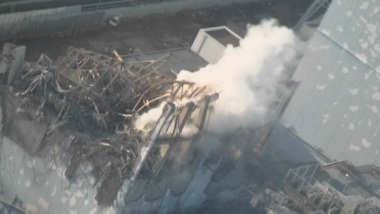Here is this weeks run down:
- UK Sticks With Nuclear Power -"Despite recent events in Japan and the certain public outcry that it will generate, the UK government proposes to build new nuclear power stations. Well, earthquakes and tsunamis are very rare here."
 Yucca Nuclear waste dump is mired in inertia $15 billion Hole to Nowhere. The license for the Yucca Mountain, which has been in development for nearly 30 years and cost more than $15 billion so far, has been in limbo since last June, when a licensing board independent of Jaczko and the rest of the commission rejected the Obama administration's request to withdraw the project application. Jaczko has yet to schedule a final vote from the five-member commission on the matter. (...) Jaczko knew his decision to shut down the technical review of Yucca Mountain, which would be used by the board to evaluate the license, "would be controversial and viewed as a policy decision for full commission consideration," the report says. "Therefore ... he strategically provided three of the four commissioners with varying amounts of information about his intention."
Yucca Nuclear waste dump is mired in inertia $15 billion Hole to Nowhere. The license for the Yucca Mountain, which has been in development for nearly 30 years and cost more than $15 billion so far, has been in limbo since last June, when a licensing board independent of Jaczko and the rest of the commission rejected the Obama administration's request to withdraw the project application. Jaczko has yet to schedule a final vote from the five-member commission on the matter. (...) Jaczko knew his decision to shut down the technical review of Yucca Mountain, which would be used by the board to evaluate the license, "would be controversial and viewed as a policy decision for full commission consideration," the report says. "Therefore ... he strategically provided three of the four commissioners with varying amounts of information about his intention."
- Radioactive Tritium Has Leaked from Three-Quarters of U.S. Commercial Nuclear Power Sites,often into groundwater from corroded, buried piping, an Associated Press investigation shows. The number and severity of the leaks has been escalating, even as federal regulators extend the licenses of more and more reactors across the nation. Tritium, which is a radioactive form of hydrogen, has leaked from at least 48 of 65 sites, according to U.S. Nuclear Regulatory Commission records reviewed as part of the AP’s yearlong examination of safety issues at aging nuclear power plants. Leaks from at least 37 of those facilities contained concentrations exceeding the federal drinking water standard — sometimes at hundreds of times the limit. While most leaks have been found within plant boundaries, some have migrated offsite.

- AP Investigation Concludes US Nuke Weakening Safety Rules "An investigation by the Associated Press has found a pattern of safety regulations being relaxed in order to keep aging nuclear power plants running. According to their investigation, when reactor parts fail or systems fall out of compliance with the rules, studies are conducted by the industry and government. The studies conclude that existing standards are 'unnecessarily conservative.' Regulations are loosened, and the reactors are back in compliance. — all of these and thousands of other problems linked to aging were uncovered in the AP's yearlong investigation. And all of them could escalate dangers in the event of an accident.'"
“Fukushima has now been classified as the biggest industrial catastrophe in the history of mankind,” with amount of radioactive fuel at Fukushima dwarfs Chernyobyl.
Arnie Gundersen has said that Fukushima is the worst industrial accident in history, and has 20 times more radiation than Chernobyl.Well-known physicist Michio Kaku just confirmed all of the above in a CNN interview:
In the last two weeks, everything we knew about that accident has been turned upside down. We were told three partial melt downs, don’t worry about it. Now we know it was 100 percent core melt in all three reactors. Radiation minimal that was released. Now we know it was comparable to radiation at Chernobyl. Radioactive materials spewed out from the crippled Fukushima No. 1 Nuclear Power Plant reached North America soon after the meltdown

The scientific journal Nature notes:The computer simulation by researchers at Kyushu University and the University of Tokyo, among other institutions, calculated dispersal of radioactive dust from the Fukushima plant beginning at 9 p.m. on March 14, when radiation levels around the plant spiked.
The team found that radioactive dust was likely caught by the jet stream and carried across the Pacific Ocean, its concentration dropping as it spread. According to the computer model, radioactive materials at a concentration just one-one hundred millionth of that found around the Fukushima plant hit the west coast of North America three days later, and reached the skies over much of Europe about a week later.
Shortly after a massive tsunami struck the Fukushima Daiichi nuclear power plant on 11 March, an unmanned monitoring station on the outskirts of Takasaki, Japan, logged a rise in radiation levels. Within 72 hours, scientists had analysed samples taken from the air and transmitted their analysis to Vienna, Austria — the headquarters of the Preparatory Commission for the Comprehensive Nuclear-Test-Ban Treaty Organization (CTBTO), an international body set up to monitor nuclear weapons tests.
It was just the start of a flood of data collected about the accident by the CTBTO's global network of 63 radiation monitoring stations. In the following weeks, the data were shared with governments around the world, but not with academics or the public.